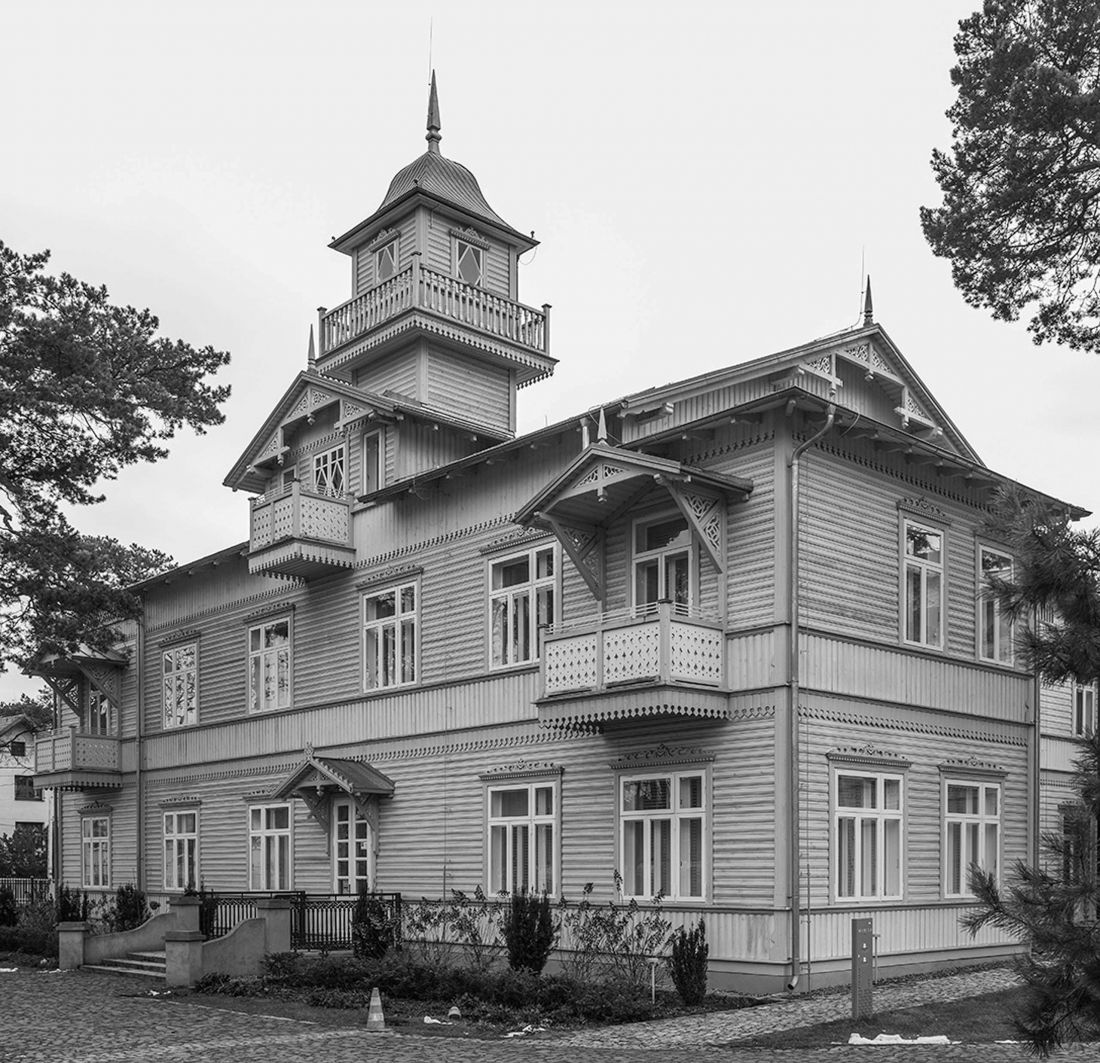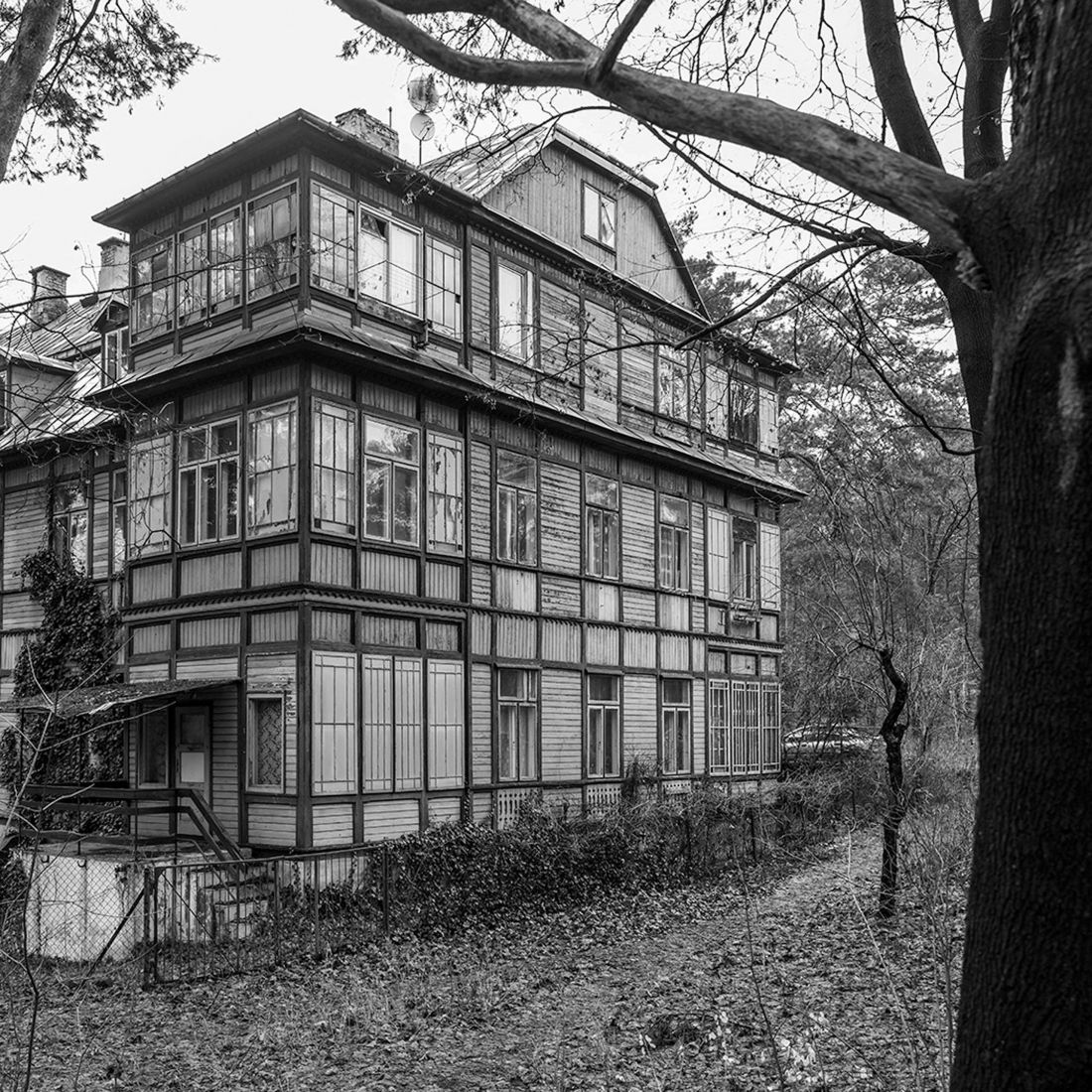The article is from A&B issue 9|23
"These villas, according to the mayor, are in the 'Świdermajer' style" - Konstanty Ildefons Galczynski wrote jokingly about the summer buildings in the so-called Otwock line, linking the name of the Świder River with a synonym for bourgeois culture, the Biedermeier style. With time, the poet's joke became an officially used name, and wooden villas - an important part of the local heritage, the complicated fate of which is told by Katarzyna Chudyńska-Szuchnik in the pages of the book "Świdermajerowie".
Katarzyna Chudyńska-Szuchnik "Świdermajerowie", Dowody Publishing House, Warsaw 2023
© Dowody Publishing House
In the beginning there was bread. Thousands of loaves delivered to occupied Warsaw from Falenica, Michalin, Józefów. The story of the Świdermajers, which sometimes housed illegal bakeries during World War II, but more often served as a source of fuel for their needs, begins in this unusual way. The author of "Swidermajers" cites the post-war press: "Several hundred wooden houses were demolished for the bakeries in Falenica," she writes, and we, the readers, already know that the journey she takes us on will not be a simple "reading about architecture."
Swiech, Russek and villas
Katarzyna Chudyńska-Szuchnik leads the reader through the pine forests located on the Świder River, showing the beginnings of the Otwock health resort. She tells about the builders who, like Jan Swiech and Stanislaw Russek, erected the first Otwock villas inspired by the 19th century designs of Bernhard Liebold and the romantic visions of Michal Elvir Andriolli. He recalls the figure of designer Isaac Wölfling, author of the modernist resort in Srodborow, and Jan Ruta, a carriage driver who drove vacationers from the Otwock station to rented accommodations. He spins a tale of the fate of the owners and residents who disappeared, leaving abandoned villas. He presents the stories of the tenants finding their new home after the war among the pine trees on the banks of the river.
The fate of the buildings is inextricably linked to the fate of the people who built them, lived in them and still live in them. Thus, the description of the construction of a typical "Świdermajer" is intertwined with anecdotes about children's games on the veranda and neighborhood quarrels. The author creates a diverse picture somewhat reminiscent of the richness of the forms of Otwock villas: here a dormer-anecdote, there again a short story-anecdote and a lace ornament of digressions.
A restored villa from Kolonia Frankówka, Jozefow
Photo: Filip Springer © Dowody Publishing House
This method of narration, however, is fraught with a certain risk, and it is easy for its author to get lost in the thicket of details. Sometimes one gets the impression that there is too much information, and Chudyńska-Szuchnik wants to tell the reader about everything. Thus, characters appear, whom we do not have the opportunity to get to know, as only one sentence is devoted to them (like Bajrych Rozenberg). Events are mentioned that, without a broader explanation, only darken the picture of the whole (for example, the issue of servitude). Undoubtedly, the author has collected a huge amount of material, and her reflections and insights are extremely interesting. Perhaps, however, a rigorous selection of information would have benefited the final shape of the book. Some of the threads beg for development, others could have disappeared without much harm to the whole.
"Świdermajer" family
One can write about architecture in many ways - from dry technical description to exalted metaphors. Katarzyna Chudyńska-Szuchnik tries to balance between these extremes. She does not shy away from professional terminology, which to a layman can sound like incantations spoken in a foreign language. At the same time, she jokingly compares the villas on the banks of the river to cakes and analyzes the process of their construction as if she were passing on a recipe for confectionery delicacies.
However, what seems most important in the story spun by Chudyńska-Szuchnik is its personal, emotional nature. The author treats the buildings described and the people associated with them with unprecedented tenderness. She leans over the fate of Leonard Ruśkiewicz's family and the Kazimierzówka villa. She smooths the wooden formwork of Irenka's walls and Felicjanka's walls plastered in a modernist manner. She looks at the decaying boards of the crumbling villas, and there is no anger or irritation in her gaze at this state of affairs. Instead, one senses a serene melancholy, similar to that which one sometimes feels when observing people in the autumn of their lives. The comparison is not accidental, for Chudyńska-Szuchnik treats villas in exactly this way - as living and feeling beings. The very title of the book "Swidermajers" suggests that we are dealing with a family saga. And indeed - in the last chapters, relatives of Otwock or Srodmajer homes appear, cousins from Ojcow, Sopot and Vilnius.
guesthouse, Otwock
Photo: Filip Springer © Dowody Publishing House
The Świdermajer family is numerous. Its roots can be traced back to the Swiss Alps, and at the turn of the 20th century relatives and affinities of the chalets there took over the spa towns in the Polish lands. From Rabka, to Ruda Pabianicka near Lodz, to Ciechocinek, to Naleczow - everywhere you will find characteristic wooden buildings with glazed verandas and laubzega-cut ornaments. They are united by formal similarity, history and completely contemporary problems. Erected as seasonal buildings, they have been neglected over the years, subjected to makeshift conversions and treated as a source of firewood.
passing of buildings
Reading "Świdermajers," the content of which is complemented by lyrical photographs of the villas (or what's left of them) on the banks of the Swidermaier River by Filip Springer, provokes the question about the future fate of the wooden buildings of the former spas. What future awaits the Świdermajers? A few years ago, the restoration of Frankówka in Józefów began, painstakingly putting together piece by piece the wooden puzzle. A similar move was made in Lodz, where the former villa of Szai Swiatlowski was not only restored, but also moved to the open-air museum of wooden urban architecture. In Jozefow, the new owners themselves are trying to restore the former splendor of the Benkówka villa. However, these are just a few examples, a handful saved in a sea of crumbling wooden buildings. What about them? Can they be saved? The book by Katarzyna Chudyńska-Szuchnik does not provide a clear answer, but it certainly makes you think. After reading it, a semi-blasphemous thought germinated in my head. Maybe the passing of the "Swidermakers" is a natural process, and we should accept that they are going away into oblivion, just like the world in which they were created? Maybe we have to accept their inexorable disappearance, and only a few relics will, as Konstanty Ildefons Galczynski wrote in 1949, stand "among the pines like wraiths in the antebellum" and speak "in a sad voice about the joys of the fin de siecle"?
Błażej Ciarkowski
Photo credit: Filip Springer © Dowody Publishing House




























